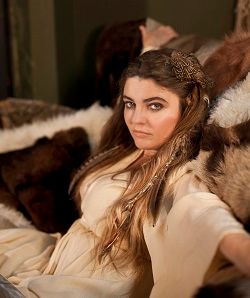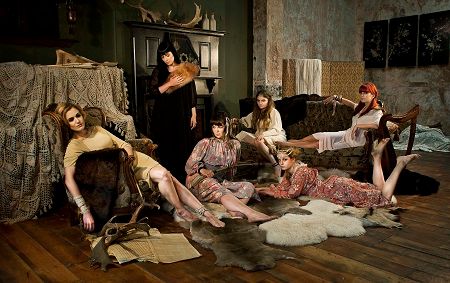![]()
Interview by Alessandra Cognetta
 I know we’re a primarily metal-based webzine, but I’m sure all of you are going to appreciate this little detour with the astonishing Mediæval Bæbes. An all-female group of talented artists from the UK, the Bæbes are a must for everyone of you out there who’s even just mildly interested in folk, classical and choral music. Haunting voices and beautiful arrangements supported by lyrics in (not only!) Middle English will take you back to the times of courtly love and ancestral symbolisms. In this interview we meet the founder and core of the group, Katharine, who kindly shared with us insights on their latest (double) album “The Huntress”, singing in different languages, visual elements, dances and much more!
Hello and welcome to Femme Metal, Katharine! It’s a pleasure to have you here and to be able to feature such a gem as the Mediæval Bæbes. How are you and how’s it going for the “Bæbes”, lately?
I know we’re a primarily metal-based webzine, but I’m sure all of you are going to appreciate this little detour with the astonishing Mediæval Bæbes. An all-female group of talented artists from the UK, the Bæbes are a must for everyone of you out there who’s even just mildly interested in folk, classical and choral music. Haunting voices and beautiful arrangements supported by lyrics in (not only!) Middle English will take you back to the times of courtly love and ancestral symbolisms. In this interview we meet the founder and core of the group, Katharine, who kindly shared with us insights on their latest (double) album “The Huntress”, singing in different languages, visual elements, dances and much more!
Hello and welcome to Femme Metal, Katharine! It’s a pleasure to have you here and to be able to feature such a gem as the Mediæval Bæbes. How are you and how’s it going for the “Bæbes”, lately?
We had a very exciting year last year. Many years of hard work finally paid off with the release of our epic double album “The Huntress”.
Your latest effort, “The Huntress”, has been released at the end of 2012. It’s a double CD where extremely talented artists come together to deliver a “feelful” (forgive the neologism but I couldn’t really find the words to describe what I felt while listening, I was utterly speechless) musical experience. As some tracks, especially in the second album and in the title itself, seem to suggest, is there a common theme to be identified through the songs?There is a strong theme of female energy represented on this album through the symbolism of the moon and the huntress. The Moon has a very powerful hold over us all and this is represented in songs such as “Cry of the Garb”, a song in early Irish which describes the perpetual ebbing and flowing of the sea, the Great, Garb, the song “Queen” and “Huntress” which describes the moon as our great shining Goddess in the sky, Clasp of a Lion, a song in Arabic, which compares two illicit lovers to the Sun in the arms of the Moon, and obviously the song “Dianae”, which speaks of the Roman Goddess of hunting and the moon.
How did you come to determine the double tracklist? Is there a reason, for example, for having all the songs in Latin on one CD?If one had to choose genres for this album , I think the best way to describe the music would be folk and classical. We have represented the duality with the concept of the double album, the first CD being more earthy and folk in feel, and the second CD taking on a more esoteric and classical tone. The songs in Latin seem to fall into this genre more readily than the songs in Middle English for example which lend themselves to a more raw approach.
Now that we know about the rest of the ensemble I’d like to turn the focus back on you, Katharine. The Mediæval Bæbes offer such a variety of elements in their music, from different languages to different genres, to the freedom that using multiple voices provides. Being the main pillar of the group, what kind of musical knowledge did you collect in time to be able to give support to such a big musical endeavor?I am a classically trained musician, lucky enough to have been given the opportunity to explore music from an early age. My journey has taken me from the formal and sometimes staid classical world into the genres of gothic rock (with my previous band Miranda Sex Garden), and experimental folk/ avant-garde classical with the Mediaeval Baebes. I have always found it exciting to take the knowledge I have garnered from my training and use it in such a way that it will appeal to an audience outside of just the classical world.
I find the process of researching and then setting ancient poetry to music very exhilarating as it is keeping the words of anonymous poets from another age alive in the consciousness of a contemporary audience whilst celebrating such timeless themes as love, sex, god and death .
The Mediæval Bæbes have offered us musical pieces in a (wide) variety of languages. What are the difficulties of such performances for you as a singer?I don’t find it difficult to sing in all these languages. It takes a bit of learning, but it is incredibly rewarding to sing and compose in all these varied tongues, because every new language that I tackle inspires me to write in a different style because of its inherent and unique rhythm and resonance.
“The Huntress” itself features lyrics in Middle English, Medieval Irish and Modern English along with Latin (and I’m not sure I spotted everything, here). I’d like to take this chance and ask you about the main lyrical themes for the album, but also to delve deeper into the language matter: what does it imply in the songwriting and what is, in your opinion, the appeal to the public of lyrics that may not be immediately understandable to everyone?The languages used on this album are Mediaeval Latin, Middle English, Modern English, Mediaeval Irish and Arabic. I think that people enjoy the contrast of modern romantic English with the mysterious qualities of the more obscure and ancient languages. Middle English reminds me of the Jabberwocky language from Lewis Carol’s “Alice In Wonderland”. You get the drift of a lot of it without always understanding individual words. Maybe it is the blood of our ancestors running through our veins which allows us to connect with these dialects in an instinctive way.

My findings are that while it is possible to be a musician and a mother at the same time, it is at the cost of compromising both. There are simply not enough hours in the day to do both jobs to the level which I would like. It does help, however to have two little girls who share my verging on unhealthy obsessions with fairy tales and all things enchanting. The fact that mummy dresses up as a fairy princess for her day job I think makes my daughters a lot more tolerant of my chosen career.
The Mediæval Bæbes recorded music for soundtracks in various occasions. How do you approach the composition process in such cases compared to when you write “for yourselves”, or anyway not out of a specific request?I have recently been working on a soundtrack for the development stage of a film called “The Fifth Sacred Thing”. It is based on the book by Starhawk and the Mediaeval Baebes are the voices of a futuristic non-violent uprising. In the past we have contributed to the Ivo Novella award winning soundtrack of the BBC dramatization “The Virgin Queen”, and the film “American Psycho”. I have recently been approached to write some music for a Mediaeval style music library which would mean writing stuff specifically for certain moods/scenes.
I really appreciated your fresh take on the “Dies Irae”, haunting and menacing at the same time, a perfect way to close a stunning album. I also loved the idea of incorporating lines from other parts of the “Requiem”. It’s a piece that has been reinterpreted and rearranged so many times and within different music genres. What inspired your peculiar version?My vision was to incorporate two atmospheres in the song, one snaky and menacing to represent the pit of Hell that the unredeemed must face and the serene and angelic to represent salvation. At the end of the piece the two “themes” mingle together to represent Hell and Heaven together here on Earth.
And what is your favourite “Dies Irae” in general (I must say Verdi‘s one holds a special place in my heart)?I also enjoy this epic piece.
Prior to the release of “The Huntress”, you have published a music video for the song “Veni Veni Bella”, filmed at a very particular location. Why choose that specific setting?The video for this song was filmed in St John’s Church in Hackney where Emily from the Baebes works. It is a beautiful spacious location that we have lucky enough to film and perform in many times.
I was really fascinated by the dances performed during the video, could you give us a bit of insight on those as well?The dance moves were choreographed by Sarah and Esther from the Baebes. The words are about the springtime joys of sexual frolicking and the music has a very courtly feel to it. I think the dance really works because it manages to incorporate the themes of sexual tension and regal ceremony.
Since we’re talking about visual elements: I really, really loved all your outfits (it’s a weakness of mine, I must admit)! Who takes care of the design, how do they come to life?The dresses have been gathered from many sources over the years. Some have been made by ex Baebe Rachel, others bought from Renaissance Festivals, others from local shops and markets. The challenge has always been to strike the right balance of romantic without looking too fancy dress whilst getting together a look which suits all the ladies. It’s a tricky one.
I’ve noticed an interesting bit in your statement on the Mediæval Bæbes website’s homepage where you mention a “mysterious” project… is it completely top secret or you can give us some clues to keep us hyped until an official announcement is released?I’m afraid this project will have to remain mysterious for now. The plan is to unveil it later on this year.
Latest Multimedia